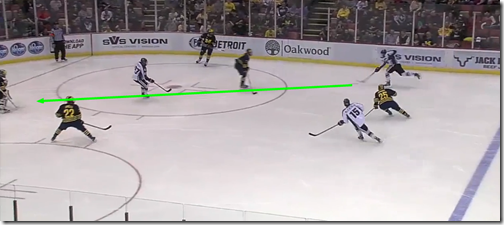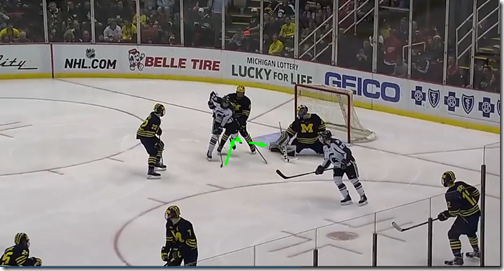1st period
UM 0 MSU 1 EV 03:09 Haag from Cox
Brennan Serville shoots and misses, and the puck hits the boards and caroms around and out of the zone. Joe Louis Arena’s boards are known for being springy, and this is a good example of that as I don’t think the puck would come as far out of the zone in a different rink as it did.
Michigan is set up for an offensive chance, so they’re naturally behind when the puck enters the neutral zone. Michael Downing is back to defend and needs to work toward the middle of the ice to break up the impending 2-on-1.
I was critical of Downing diving on Twitter, but now that I’ve had the benefit of watching the play over and over again in slow motion I have to take that back. His job on a 2-on-1 is to take away the pass so that Nagelvoort can take the shooter, which is what he’s clearly attempting in the screen cap below. His dive fails because Cox delivers a perfect saucer pass over Downing’s stick. I used to try saucer passes in Ea Sports’ NHL series and was never able to execute one as well as this.
Nagelvoort has to adjust in this frame. His job has changed from taking the presumed shooter (Cox) to pushing laterally and covering the actual shooter (Haag).
Haag tries to hit the near-side corner. The puck hits Nagelvoort in the shoulder and is deflected up and into the corner of the net. Michigan’s goalies have terribly unlucky shoulders.
[After THE JUMP: Are teams allowed to go more than 20 minutes without scoring? I investigate]
UM 1 MSU 1 EV 16:08 Larkin (10) from Hyman (20) and Nieves (13)
Boo Nieves draws half of Michigan State’s defenders by skating the puck down the boards. He sees the pressure coming and finds the open man behind the net, Zach Hyman. Hyman is open because he was able to slip behind the defense (and the net) unnoticed.
Hyman looks up and sees Dylan Larkin unconscionably open in the opposite faceoff circle. In a game where goals apparently only come off of ridiculous airborne passes, Hyman flicks the puck to Larkin.
Larkin snags the puck out of the air and drops it. He immediately gets a shot off, a perfectly placed snapshot that is placed just inside the defender before it finds the far-side top corner. Hildebrand had no chance at stopping this; he’s been in his butterfly since Hyman had the puck behind the net so he’s not able to take away the top corners, and he can’t see with two teammates screening him.
2nd period
No scoring.
Contrary to what the last month and a half have led you believe, this is within the rules. I even used ctrl+f to search the rule book to confirm for you, dear reader. Please remember to link back to this post when I make it big as an investigative journalist.
3rd period
UM 1 MSU 2 EV 01:58 DeBlouw from Holland
The puck is rimmed around the boards and Nieves tries to close on it. He isn’t able to seal it along the wall and the puck glides past him. This shouldn’t be complicated. Now the puck is turned over right in front of a Michigan State skater with no one close to being able to cover him.
Holland has a one or two second window where he can get a clean shot off before he’s covered. He takes the shot. He’s not stupid.
We have to switch to a different camera angle to adequately see what happens; this shot is from behind Holland. DeBlouw moves in from near the faceoff circle to set up in the slot for a redirection. He sees the puck coming and turns his blade so that it’s closed, which creates an inclined plane that should send the puck high. Credit where it’s due: DeBlouw made a really smart move in closing his blade.
The puck does start to go toward the top of the net, but it runs into something on the way. It hits DeBlouw’s shin pad and is redirected toward the open portion of the bottom of the net. Nagelvoort had absolutely no chance at stopping this; it’s a redirection that itself changes direction. The hockey gods can be so callous.
Notes:
The goal that wasn’t there
Would have been UM 2 MSU 1 EV (4v4) 05:34 Copp from Motte
Andrew Copp gets hooked after pulling the puck through Boyd’s skates. He’s still able to jam the puck into Hildebrand’s pads after the hook. Regardless of what happens in the rest of the sequence Michigan’s going to get a 4-on-3 power play.
Hildebrand is unable to keep the puck in his pads. Copp gets another chance, poking the puck under Hildebrand’s leg. You can see that the puck isn’t across the line yet and the ref has not yet blown the whistle.
From this angle it looks like the goal is good…
…but not from this angle. I’ve drawn over the goal line to make it easier to see, and here it looks like the ref has blown the whistle just before the puck crosses. The puck, mind you, is the little spherical thing right in front of the goal line (I forgot to draw an arrow).
I’m not surprised that this wasn’t overturned. First of all, this is college hockey so we’re at the whim of the referee and his intent to blow the whistle. There’s not a great camera angle either; it looks different on the two I’ve included above, and I was only able to get those using super slow motion on my computer. When I watched the replay on my DVR it was impossible to definitively tell when the puck crossed in relation to the whistle. Any goal that’s initially waved off is going to need extremely convincing video evidence to end up being deemed a good goal, and this one certainly does not have that.
- Michigan State spent most of the third period calling off the forecheck in favor of a defense that looked like they took a page out of Stan Van Gundy’s playbook. That’s a f-ing wall, and Michigan ran themselves into it over and over again late in the game.
- Michigan started skating the puck in on the wall and to the back of the net to combat MSU’s trap. They were able to gain the zone fairly frequently, but Michigan had a terrible night passing, and they were unable to move the puck crisply enough to get Hildebrand or the defense moving.
- There was a point in the game where Compher skated from the blue line to the back of the net, was unable to find anyone open enough to be worth of a pass, and ended up with the puck knocked off his stick near the opposite side of the blue line after making a near-complete circle of the offensive zone’s perimeter.
- Zach Hyman’s decided that the back of the net is his territory, and MSU didn’t try to change that. At least half a dozen times he set up behind the net; sometimes he was looking for an open teammate (like the goal Larkin scored) and other times he was looking to create for himself from either side. He tried to skate out from behind and use what’s becoming his patented backhanded shot to hit the top corners more often than he went to the forehand.
- The Downing/Serville defense pair was driving me crazy by the midpoint of the first period. I’d like to put Sinelli with Downing to give him a responsible defense partner that will be able to cover when Downing goes all-in and tries something risky, whether it be diving or going for the big hit or pinching in the offensive zone. Serville makes similarly dangerous decisions, and I’d rather he do that with Cutler Martin than Downing.
- Michigan was averaging 6.5 goals per game in Big Ten play going into Friday’s game while Michigan State was averaging 2.5 goals allowed per game. Both of these numbers was first in the conference, so something had to give. Michigan State’s had a tendency to lose by quite a few goals in one game of a series and then either shut out their opponent or give up a single goal in the other game. In other words, their defense is good but inconsistent. Michigan’s offense had been surprisingly consistently prolific over the past two months until Friday.
- PairWatch: Michigan’s sitting at #14 in the PairWise, which isn’t bad. Minnesota’s still hanging around the top 20 (#19) despite tying Wisconsin on Saturday, while UMass-Lowell is #13. Keep an eye on Penn State; they’re #22 and could help Michigan if they move into the top 20 (quality win bonus) and if Michigan beats them on the road (road win multiplier).
- Next game: vs. Michigan State, Saturday, Feb. 7 at 8 pm (at Soldier Field in Chicago)



































